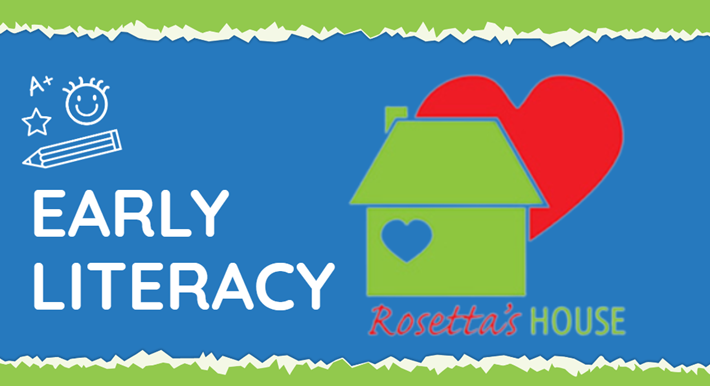
Rosetta’s Hours:
Monday to Thursday – 9 am to 8 pm
Friday – 9 am to 4 pm
Saturday – 10 am to 4 pm
Rosetta’s House closes an hour before the library in order to allow staff to sanitize the toys, etc.
Rosetta’s House is an early literacy educational center for younger children (under 6 years old) and their caregivers to help children learn and explore while having fun.
“Early literacy” is a term for what children know about language before learning how to read. This includes what letters look and sound like, recognizing rhyming words, knowing how a book works and recognizing that printed text has meaning. These concepts are learned by talking, singing, reading, writing and playing with a caregiver.
Rosetta’s House has a direct focus on these skills. The center offers a variety of board books, a reading nook, fine motor and interactive sensory walls, and other play elements.
View Rosetta’s House Guidelines Here

There are several things parents and caregivers can do to support the development of their child’s early literacy skills. Among them are five simple practices: singing, talking, reading, writing and playing. Promoted by the Every Child Ready to Read initiative. These practices are very doable for parents and caregivers, and they can be adapted to suit a child’s individual learning needs. Read on to discover some specific ways to include children of all abilities in these early literacy skill building practices!
Sing
Singing is a great way to learn about a language. When we sing, the sounds that make up words become more evident.
- Sing the alphabet and nursery rhymes, listen to recorded music or clap along to a song to demonstrate syllables.
- If your child’s ability to verbalize or hear makes singing difficult, engage them in other rhythm-building activities like hand clapping, marching and body swaying to music.
Talk
Children need to receive and create language to learn it.
- Talk with your child and around your child. If your child is blind or has low vision, describe the things you see to them. Describe the things in their environment that they can feel, hear, smell and taste.
- Encourage your child to talk. Ask questions. Respond to what your child says. After asking a question, silently count to ten to give them plenty of response time.
- If your child is nonverbal and uses an alternative communication system, such as a picture board or a speech-generating device, you can encourage them to speak by entering into their world with motivating people or objects, labeling feelings as they occur (for instance, if your child is reaching for food, say “You are hungry.”) and modeling your language with your child’s communication system.
Read
Share books together!
- Books with tactile features, like Counting by Fleur Star and Never Touch the Monster! by Rosie Greening, are great for children with visual impairments. For the child who can’t see or has limited vision, tactile features are like illustrations.
- Use toys and real objects to illustrate the book. For example, while reading the well-loved folktale, Stone Soup, have real objects from the story ready for your child to explore —a soup pot, a stone, an onion, a carrot, salt and pepper and more! Using real objects to reinforce key ideas while reading benefits all children, particularly children with developmental disabilities.
- Try audio books! Audiobooks are available via BookFlix or Libby Kids.
Write
Scribble, draw and make tactile art.
- A child’s scribbles are precursors to adult calligraphy. Practice writing in different ways – with crayons, pencils, markers, finger paints, a braille slate and stylus for the child with blindness or low vision, with a computer or an iPad. If it involves mark making of some kind, it’s writing! You could also try making tactile art. For a wealth of tactile art ideas, check out org’s Tactile Art for Blind Children.
- Some children may have a hard time with writing activities due to physically based disabilities. Consider adaptive tools like pencil grippers and chunky crayons if your child has limited manual dexterity. Give alternative activities that don’t involve physically putting pen to paper a try, like using an iPad with a kid-friendly art app, like Doodle Buddy, for the iPad.
- Talk to them about what they create and write. Encourage them to talk to you about what they create and write.
Play
Children experience the world through play while developing fine and gross motor skills, cognitive concepts, language and social skills.
- Create a safe space for play and encourage your child to explore their environment. Some children may need extra support when engaging in independent exploration.
–If your child is blind or visually impaired, define their space with meaningful objects kept in predictable, accessible and detectable locations. - Provide toys that engage many senses – rattles, textured balls, vibrating toys and colorful blocks.
– Encourage your child to pretend and create stories!
Ready to sing, talk, read, write and play, but not sure where to start?
Visit the Library to check out books, play with developmentally appropriate toys, explore technology, attend a storytime or play program or speak with a Children’s Librarian about early literacy and learning.
